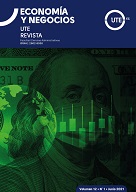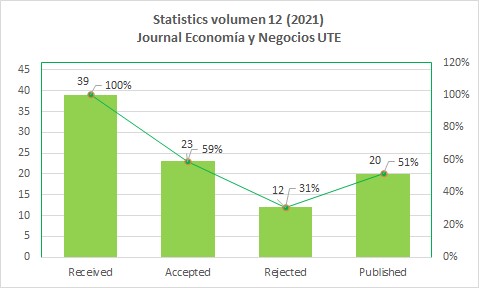Variables Determinantes de las Prácticas de Gestión de Recursos Humanos en Micro y Pequeñas Empresas
DOI:
https://doi.org/10.29019/eyn.v12i2.944Palabras clave:
Gestión de recursos humanos, Micro y pequeñas empresas, Empresas medianas y grandesResumen
En la actualidad, son escasas las investigaciones que profundizan en los pormenores de la gestión del talento humano para micro y pequeñas empresas. Por medio de esta investigación se pretende caracterizar en qué medida las prácticas de gestión de recursos humanos (GRH) de las micro y pequeñas empresas en Ecuador difieren o se asemejan a las prácticas de esta disciplina en las medianas y grandes empresas. Para este fin se tuvo acceso a información sobre la forma en que se desarrolla esta área de gestión en 974 organizaciones representativas de los distintos estratos del universo de empresas de la población en estudio, y sobre el grado de aplicación de las distintas funciones. Además, se evaluaron otras variables como el número de trabajadores y la edad de la empresa. Como resultado fundamental se estableció la existencia de niveles de correlación entre el grado de desarrollo de la actividad y el tamaño y antigüedad de la empresa. Asimismo, se encontró que el nivel de desarrollo de las funciones de GRH, en particular, y de la actividad, en general, varía en correspondencia con el tipo de organización.
Descargas
Citas
Acikgoz, Y. (2019). Employee recruitment and job search: Towards a multi-level integration. Human Resource Management Review, 29(1), 1–13. https://doi.org/10.1016/j.hrmr.2018.02.009
Aguinis, H., & Bakker, R.M. (2021). Time is of the essence: Improving the conceptualization and measurement of time. Human Resource Management Review, 31(2), 100763. https://doi.org/10.1016/j.hrmr.2020.100763
Ahammad, M.F., Glaister, K.W., & Gomes, E. (2020). Strategic agility and human resource management. Human Resource Management Review, 30(1). https://doi.org/10.1016/j.hrmr.2019.100700
Barrett, R., & Mayson, S. (2006). Exploring the intersection of HRM and entrepreneurship: Guest editors’ introduction to the special edition on HRM and entrepreneurship. Human Resource Management Review, 16(4), 443-446. http://dx.doi.org/10.1016/j.hrmr.2006.08.001
Batistič, S. (2018). Looking beyond - socialization tactics: The role of human resource systems in the socialization process. Human Resource Management Review, 28(2), 220-233. https://doi.org/10.1016/j.hrmr.2017.06.004
Borjas, G.J., & Doran, K.B. (2015). Prizes and productivity: How winning the fields medal affects scientific output. Journal of Human Resources, 50(3), 728-758. https://doi.org/10.3368/jhr.50.3.728
Bush, J.T. (2020). Win-Win-Lose? Sustainable HRM and the promotion of unsustainable employee outcomes. Human Resource Management Review, 30(3). https://doi.org/10.1016/j.hrmr.2018.11.004
Cardon, M.S., & Stevens, C.E. (2004). Managing human resources in small organizations: What do we know? Human Resource Management Review, 14(3), 295-323. https://doi.org/10.1016/j.hrmr.2004.06.001
Carpenter, C. S., Dobkin, C., & Warman, C. (2016). The mechanisms of alcohol control. Journal of Human Resources, 51(2), 328–356. https://doi.org/10.3368/jhr.51.2.0314-6240R
Cellini, S.R., & Turner, N. (2019). Gainfully employed?: Assessing the employment and earnings of for-profit college students using administrative data. Journal of Human Resources, 54(2), 342-370. https://doi.org/10.3368/jhr.54.2.1016.8302R1
Combs, J. G., Jaskiewicz, P., Kristen, K., Shanine, K. K. & Balkin, D. B. (2018). Making sense of HR in family firms: Antecedents, moderators, and outcomes. Human Resource Management Review, 28(1), 1–4. https://doi.org/10.1016/j.hrmr.2017.05.001
Daspit, J.J, Kristen, M., Barnett, T., & Long, R.G (2018). The emergence of bifurcation bias from unbalanced families: Examining HR practices in the family firm using circumplex theory. Human Resource Management Review, 28(1), 18-32. http://dx.doi.org/10.1016/j.hrmr.2017.05.003
Degbey, W.Y., Rodgers, P., Kromah, M.D., & Weber, Y. (2020). The impact of psychological ownership on employee retention in mergers and acquisitions. Human Resource Management Review, 31(3) https://doi.org/10.1016/j.hrmr.2020.100745
Han, J., Sun, J.M., & Wang, H.L. (2020). Do high performance work systems generate negative effects? How and when? Human Resource Management Review, 30(2). https://doi.org/10.1016/j.hrmr.2019.100699
Hensvik, L., & Rosenqvist, O. (2019). Keeping the production line running: Internal substitution and employee absence. Journal of Human Resources, 54(1), 200–224. https://doi.org/10.3368/jhr.54.1.0516.7914r1
Instituto Nacional de Estadística y Censos (INEC). (2018, 30 de mayo). Visualizador de estadísticas productivas. https://bit.ly/2ZYkemx
Johnson, A.F., & Roberto, K.J. (2019). Elections and selection: The role of political ideology in selection decisions. Human Resource Management Review, 29(1), 14–27. https://doi.org/10.1016/j.hrmr.2018.05.003
Krishnan, T.N., & Hugh, S. (2017). Talent management and dynamic view of talent in small and medium enterprises. Human Resource Management Review, 27(3), 431–441. https://doi.org/10.1016/j.hrmr.2016.10.003
Lohaus, D., & Habermann, W. (2019). Presenteeism: A review and research directions. Human Resource Management Review, 29(1), 43–58. https://doi.org/10.1016/j.hrmr.2018.02.010
Lozano-Reina, G., & Sánchez-Marín, G. (2020). Say on pay and executive compensation: A systematic review and suggestions for developing the field. Human Resource Management Review, 30(2). https://doi.org/10.1016/j.hrmr.2019.01.004
McClellan, C., & Tekin, E. (2017). Stand your ground laws, homicides, and injuries. Journal of Human Resources, 52(3), 621–653. https://doi.org/10.3368/jhr.52.3.0613-5723R2
Miao, C., Qian, S., Banks, G. C., & Seers, A. (2020). Supervisor-subordinate guanxi: A meta-analytic review and future research agenda. Human Resource Management Review, 30(2). https://doi.org/10.1016/j.hrmr.2019.100702
Organización para la Cooperación y el Desarrollo Económico (OECD). (2015). Taxation of SMEs in OECD and G20 countries: OECD Tax Policy Studies, n.o 23. OECD Publishing.
Stone, C. & Stone, D. L. (2015). Factors affecting hiring decisions about veterans. Human Resource Management Review, 25(1), 68-79. https://doi.org/10.1016/j.hrmr.2014.06.003
van Dijk, H., Shantz, A., & Alfes, K. (2020). Welcome to the bright side: Why, how, and when overqualification enhances performance. Human Resource Management Review, 30(2). https://doi.org/10.1016/j.hrmr.2019.04.004
Wilkinson, A., Barry, M., & Morrison, E. (2020). Toward an integration of research on employee voice. Human Resource Management Review, 30(1). https://doi.org/10.1016/j.hrmr.2018.12.001
Descargas
Publicado
Cómo citar
Número
Sección
Categorías
Licencia
Derechos de autor 2021 Los Autores

Esta obra está bajo una licencia Creative Commons Reconocimiento 3.0 Unported.
Los artículos e investigaciones publicadas por la Universidad UTE, se realizan en régimen de Acceso Abierto [Open Access] en formato electrónico. Al enviar un artículo a cualquiera de las revistas científicas de la Universidad UTE, el o los autores aceptan estas condiciones.
La UTE aplica la licencia Creative Commons Attribution (CC-BY) a los artículos de sus revistas científicas. En virtud de esta licencia de acceso abierto, como autor usted acuerda que cualquier persona puede reutilizar su artículo en su totalidad o en parte para cualquier propósito, de forma gratuita, incluso para fines comerciales. Cualquiera puede copiar, distribuir o reutilizar el contenido siempre y cuando el autor y la fuente original estén correctamente citados. Esto facilita la libertad de reutilización y también asegura que el contenido pueda ser extraído sin barreras para necesidades de investigación.
Licencia Creative Commons Atribución 4.0 Internacional
La Revista Economía y Negocios está distribuida bajo una
Creative Commons Attribution 4.0 International (CC BY 4.0).

Además, la Revista Economía y Negocios garantiza y declara que los autores conservan siempre todos los derechos de autor y de publicación de sus obras originales sin restricciones [© Los Autores]. El reconocimiento (BY) permite cualquier explotación de la obra, incluyendo una finalidad comercial, así como la creación de obras derivadas, la distribución de las cuales también está permitida sin ninguna restricción.















